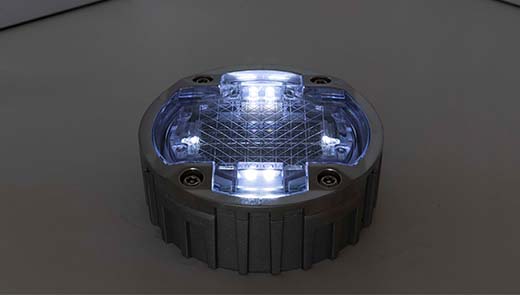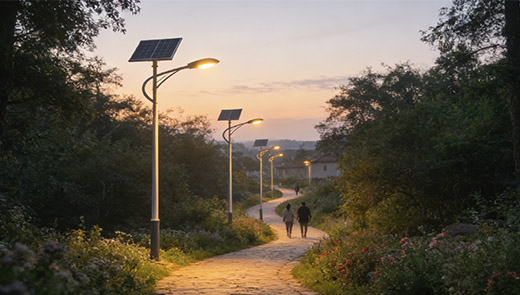How Do Solar Street Lights Implement The Motion Sensor Function?
Against the backdrop of the global push toward green energy transition, solar street lights have become an important choice for outdoor lighting scenarios such as urban roads and rural paths due to their energy-saving and environmentally friendly characteristics. The application of motion sensors has further endowed solar street lights with “smart” attributes, making the lighting system more intelligent and efficient. So, how exactly do solar street lights implement the motion sensor function? What are the advantages and limitations of this technology? We will provide a detailed explanation below.
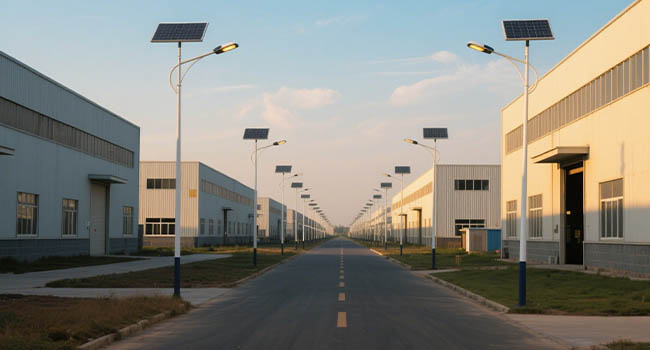
Understanding Motion Sensor Technology
Motion sensors serve as the core components enabling smart lighting in solar street lights, operating primarily through the following technical principles:
Passive Infrared (PIR) Sensors
Passive infrared sensors function based on the infrared radiation characteristics of objects. In nature, all objects with temperatures above absolute zero emit infrared radiation. PIR sensors are equipped with special infrared sensing elements. When a moving object, such as a pedestrian or vehicle, enters their detection range, the infrared radiation emitted by the object alters the infrared radiation pattern detected by the sensor, triggering it to send a signal to the street light control system and activate the lighting equipment.
PIR sensors are widely used in outdoor lighting applications due to their high reliability and low cost. They are easy to install and maintain, and can reliably detect motion under normal weather conditions.
Microwave Sensors
Microwave sensors emit low-power microwave signals and detect motion by receiving signals reflected back from surrounding objects. When an object moves within the detection area, the frequency of the reflected microwaves changes. The sensor uses this frequency change to accurately identify the presence of motion. The advantage of this technology is its ability to penetrate non-metallic obstacles such as glass and plastic, and it is less affected by adverse weather conditions, enabling effective motion detection even in rain, snow, or fog.
Ultrasonic Sensors
Ultrasonic sensors operate by emitting high-frequency ultrasonic waves and receiving the sound waves reflected back from nearby objects. By calculating the time difference between the emitted and received sound waves, the distance and position of the object are determined. When an object moves within the detection range, the pattern of the reflected sound waves changes, and the sensor detects the movement and triggers the street light illumination. Ultrasonic sensors are highly sensitive to small movements and are commonly used in indoor or specific outdoor scenarios where high detection accuracy is required.
Dual Technology Sensors
To further enhance motion detection accuracy and reduce false alarms, dual-technology sensors have been developed. These sensors typically combine two or more detection technologies, such as the common combination of PIR and microwave technology. Lighting is only activated when both technologies detect motion simultaneously, significantly reducing false triggers caused by environmental factors like wind rustling leaves or small animals passing by, thereby greatly improving the reliability of motion detection.
Implementation in Solar Street Lights
Motion Sensor Selection
When selecting motion sensors for solar street lights, multiple factors must be considered. First is the detection range, which should be determined based on the installation height of the street light and the size of the illuminated area to ensure adequate coverage of the required lighting zone. Second is sensitivity, as different application scenarios have varying requirements for motion detection sensitivity. For example, busy streets with high foot traffic and rural paths with sparse pedestrian traffic require different levels of sensitivity.
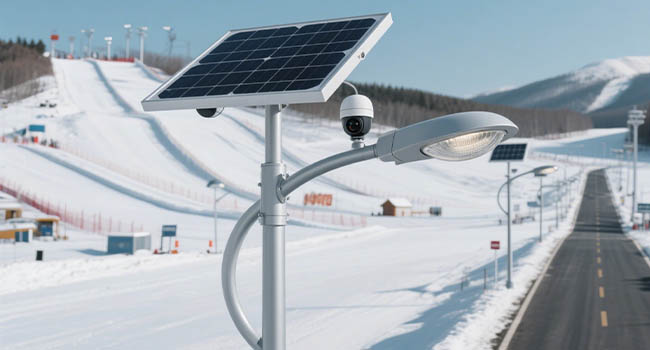
Additionally, environmental conditions at the installation site, such as the presence of obstructions or local climate characteristics, also influence sensor selection. Generally, in standard outdoor environments, PIR sensors are commonly used due to their cost-effectiveness; however, in complex environments or areas requiring high detection accuracy, microwave sensors or dual-technology sensors are preferred.
Integration into Luminaire
The installation location of the motion sensor directly impacts its detection performance. Typically, sensors are integrated into the interior of solar street light fixtures or installed in an independent housing near the fixture. During installation, the sensor's height and angle must be precisely adjusted to ensure maximum detection range without blind spots. Additionally, factors such as the overall design of the fixture, sensor orientation, and potential obstacles in the surrounding area must be fully considered to avoid improper installation affecting the sensor's normal operation and the street light's lighting performance.
Wiring and Connectivity
Motion sensors are connected to the solar street light's lighting control system via wiring, establishing a signal transmission channel. Connection methods can either use traditional wired connections, utilizing wires to transmit signals between the sensor and controller—this method ensures stable signals but has relatively low installation flexibility—or wireless connection technologies such as Bluetooth or Wi-Fi, enabling more convenient installation and system integration. However, wireless connections may encounter issues like signal interference. Through wired connections, sensors can promptly and accurately transmit detected motion signals to the controller, providing the basis for subsequent lighting control.
Trigger Mechanism
When the motion sensor detects movement within the area, it immediately generates an electrical signal and transmits it to the street light controller. Upon receiving the signal, the controller controls the LED lights based on pre-set programs and parameters. For example, when there are no people or vehicles present, the street light remains at low brightness or turns off to conserve energy; once motion is detected, the controller quickly issues instructions to increase the brightness of the LED lights, providing adequate illumination.
Customization and Settings
The solar street light motion sensor system offers extensive customization options. Users can adjust the sensor's sensitivity according to actual needs, enabling the sensor to accurately detect motion of varying intensities and speeds. The time delay setting function allows users to specify the duration for which the street light remains at high brightness after no motion is detected, preventing frequent on/off cycles. Additionally, the daylight sensing function automatically turns off the street light during daytime when natural light is sufficient, further conserving energy. These customizable features enable the solar street light system to better adapt to diverse usage scenarios and user requirements, achieving efficient energy utilization.
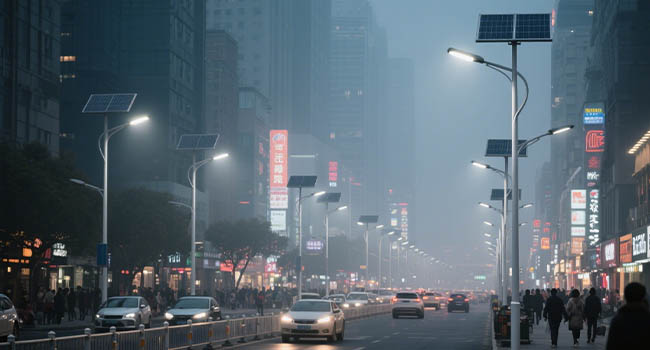
Solar Street Light with Motion Sensor Advantages
Energy Saving
The solar street light motion sensor automatically adjusts brightness based on actual needs. When pedestrians or vehicles are detected, the street light automatically increases brightness; when no one or no vehicles are present, the street light reduces brightness or even turns off, effectively reducing unnecessary energy consumption and significantly improving energy efficiency.
Extend Service Life
Since the street light automatically reduces brightness when no one or no vehicles are present, this significantly reduces the workload on the LED light beads. Traditional street lights that remain fully illuminated at all times keep the LED light beads in a high-load operating state. Prolonged heating and continuous illumination accelerate the aging of the semiconductor materials inside the light beads, leading to accelerated light decay, reduced brightness, or even damage.
Solar street lights equipped with motion sensors operate at low brightness most of the time, significantly reducing the operating time and heat generated by LED lamp beads. Operating at low load for extended periods effectively slows down the aging of LED lamp beads, reduces light decay, and lowers failure rates. According to professional test data, compared to conventional street lights, solar street lights with motion sensors can extend the lifespan of LED chips by 3–5 years, thereby extending the overall lifespan of the street light system, significantly reducing maintenance and replacement costs, and decreasing the frequency and expenses of manual inspections.
Improve Safety
At night, when pedestrians or vehicles approach, the street lights quickly increase brightness to provide better illumination. Bright lighting not only helps pedestrians see road conditions clearly and ensures walking safety but also allows drivers to observe road conditions more clearly, reducing the occurrence of traffic accidents. Additionally, adequate lighting can deter criminal activities, lowering crime rates and enhancing regional safety.
Reduce Light Pollution
Street lights controlled by motion sensors reduce brightness when there is no activity, avoiding excessive light scattering. This effectively reduces light interference with the surrounding environment and residents' lives, playing a positive role in protecting the ecological environment, maintaining astronomical observation conditions, and ensuring residents' normal rest.

Solar Street Light with Motion Sensor Disadvantages
Relatively High Cost
Solar street lights require the integration of motion sensors and corresponding control systems, which inevitably increases production complexity and costs. From R&D design, component procurement, to assembly and testing, additional investments are required, making the price of solar motion sensor street lights significantly higher than ordinary solar street lights. For projects with limited budgets, the relatively high initial investment may be a barrier.
Environmental Restrictions
In certain environments, the performance of motion sensors may be affected. For example, in densely populated urban areas, buildings may obstruct the sensor's detection range, creating blind spots; in forested areas, wind-blown leaves may interfere with the sensor, reducing its sensitivity. Additionally, extreme weather conditions such as heavy rain, snowstorms, or dust storms may disrupt the sensor's normal operation, affecting its detection accuracy.
Possible False Triggering
Due to the detection principle of motion sensors, the movement of some non-target objects may also cause false triggering. For example, small animals running quickly or plastic bags blown by the wind may be mistaken by the sensor as pedestrians or vehicles, causing the street lights to frequently adjust their brightness. This not only causes unnecessary energy waste but may also disturb nearby residents and reduce the user experience.
With the continuous advancement and innovation of technology, the shortcomings of solar street light motion sensor technology are gradually being addressed. In the future, more efficient, precise, and cost-effective motion sensors will continue to emerge, driving solar street lights toward more intelligent and energy-efficient development, and contributing greater efforts to the global green lighting industry.

